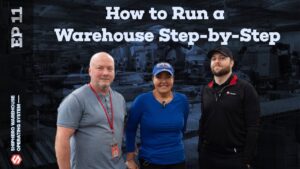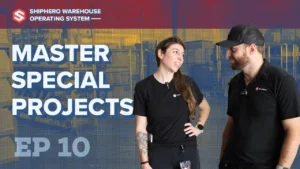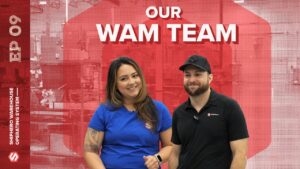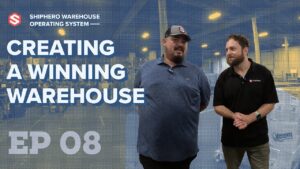Video Transcript
- Hello everyone and welcome to another episode of "ShipHero Feature Walkthroughs." I'm joined today by Valerie Cancian, our Product Manager. How are you today, Valerie?
- Hello. I'm doing very well. How are you, Danno?
- Awesome. I'm doing great.
- I'm liking the glasses today, very studious. I feel like.
- Thanks.
- I should wear mine and like level up a little bit.
- Maybe for the next feature walkthrough.
- There we go. I'll remember.
- There it is. Okay. Obviously, as usual, I'm looking forward to learning more about ShipHero. So what feature are we exploring today, Val?
- All right, so we're gonna take a look at the wholesale feature which we actually have done a walkthrough of already, but there's a couple different flows. So there's the courier flow which we have another video definitely go checkout, which is gonna be the end to end of how to mark an order as wholesale and then how to pick it, pack it, and generate shipping labels to ship out that order. However, there is another flow for wholesale, the freight flow, and that's what we're gonna look at today. It's very similar, so we're going to just touch upon parts that were already addressed in the courier flow. And if you want more detail, definitely check it out in our other video, but then we're going to focus in on what makes it different, what makes the freight flow special. So when we're ready, we'll dive into this and take a look. All right, so we're gonna start here in wholesale. In our previous video, we addressed how you get here. You mark an order with a wholesale toggle, and it'll show up on your wholesale dashboard. You're able to enter the order, and it'll bring you to this page. Similar to the courier flow, you're gonna need to pick this order, pack this order, but instead of generating labels such as a UPS label or a USPS label, you're going to generate pallet labels for your freight orders, as well as packing slips, and a packing list of everything that you have for your order. So a few things to note on this page. Up on top here, you'll see it says, Freight. Previously, we looked at Courier. Today we're gonna look at Freight, so you wanna make sure you're on the Freight setting. You'll see here I'm not yet able to print the packing labels or the pallet labels. This is because I didn't finish packing this yet. I wanted to just do a little refresher on how to pack before we got there, but there are a few other fields I wanna draw attention to. You'll see here we have shipping details For the courier flow, this wasn't as necessary, but for freight, this way you could put in your freight information. Who's gonna pick it up? What the SCAC number is, your BOL, Bill of Landing, what the cost for this freight order, tracking numbers from your freight company, PRO numbers, this could all be saved here. You obviously have access to your attachments. These could have been added when the order was created. They also can be added at this point. You can attach additional files, any sort of forms that you might need for your freight company can be here. And these can just be downloaded, so that you have them all in one space. And of course, your timeline is tracking everything. For this demo, I'm gonna put in a trailer number here, just so we have, that's just gonna be a pretend number, just so this data is filled in. This is usually a two-digit. Now, we're gonna make up a little company here. Once this is all filled in, and you don't have to fill in any of these, they're not required. This is just optional for your own reference. You have this saved and then just hit save details. And there you go. All right, so when it comes to picking a freight order, it's the same as courier. You have your two options. You can simply assign locations which is what I did here hit assign location, and choose a pick location for your SKU. Once you choose that location, that's allocated to the order, and you are able to then start packing them. Or you can go through the QR code picking flow, in which case, you would not assign a location. Instead you would just generate this QR code, scan it into mobile, then you would pick them, move them to staging. And once you have them in staging, you would assign that location here. We have a video on the QR picking flow to watch for more details, but those are your two options for picking a freight order, same as with the courier flow. Once everything is picked, you'll see these check marks that it's all good to go, and then you'll start packing. So here's where it's a little bit different. In couriers, you get boxes. You get a box, you put your items in the box, put the label in the box, you ship it. For freight, you're gonna have pallets. So here, you'll be able to add a new pallet. And I started this off because the packing process is tedious, and we went over it in the courier flow. But we will do a few together at the tail end here. So you put your first pallet and then you're able to add items to the pallet. So I have my cases here, these are pre-built cases, all of six. I put all a hundred, stacked them up on the pallet. The weight was updated. You can manually update this, or it will update if you have the weight of your product saved. We'll just update for you which we'll see when we pack the next few items. Choose your pallet which have your length and width. A note on the height, we don't necessarily know the height. It depends on how high you stack your pallets, so that is something you will need to update at the end manually. So just kind of keep that in mind. We'll set a default depending on your pallet height, but usually a pallet itself is about three inches or so. But obviously, once you're done stacking all the boxes, we're gonna have to increase that. So you'll pack your pallets. You can have as many pallets as you need, depending on the size of your order. Here, I to a box and a few items for each. Obviously, set my box, the weight, adjust to the height. Let's do one together, so you'll add a new pallet. Suggest, I have a pallet saved with these dimensions. This is in my box section. This is the weight of the pallet by itself, just empty. We will add in our box. This can be done scanning, of course, but this we'll do our first here. And we'll sweat and again, these can be scanned in. And then we'll add a second box. All right, and that should be everything that we need packed. So as you'll see, the weight did update on its own. Let me update this box. As you see, it updated and the weight also updated. If you have scales like a pallet scale, this does work. Just make sure you are hovering over the pallet that you are actually weighing, and it will update that way similar to the courier flow. Not everyone has pallet skills, in which case, as long as your items have weights, your boxes have weights, we'll do the calculation for you. All right, so everything is packed. And now, you will see that you're able to print your packing and pallet labels. So when you click here, we have pallet labels, packing lists, and packing slips. So the difference between the list and the slips, and these are optional, we generate both of them. Some may use the list, some may use the slips. The list is just overall, all of your pallets and what is in them which we'll take a look at. While the slips is like per pallet, or per box, I believe, all are generated. So let's take a look at those. So we'll generate our packing list. So what you'll see here is just like an overview of everything, so you have your order number. You'll have those shipping details that we put in earlier. You'll have your placement date, who's receiving this, and then you'll have your pallet. What is in your pallet, the quantity, the dimensions, the weight, if there are lock codes, that would be visible here as well. And this is just an overview of everything. One pallet, two pallets, three pallets, all of the boxes, everything in total for this order, the total weight of the order, the total amount of pallets, the total amount of items. So this is your list. And if we go back, here, then you also can unpacking slips which I'll show you. These all generate as a PDF, so you can just print them out. You can also print out multiple copies if you would like. So here you have the first ones. This is our first pallet and what is on that pallet. This could be a lot of sheets, just a heads up. And then this is our second pallet and the first box. So if you wanted to put this directly in the box, you could. So whoever opens the box, knows what's in there. When it's just one item like this, it's pretty straightforward, but sometimes, boxes could have a lot of items. So, you might wanna put in a packing slip for exactly what's in the box, so there's no surprises. Whoever's receiving it, they know they received the right items. So this would your next box and all of your boxes, so it tells you what pallet, what box. And these can go into your boxes or into the pallet itself when you wrap it up with plastic before you ship it off, you can put this in there with the pallet itself. So just options, so you know what was packed there, whoever's receiving it, doesn't have any surprises. And then the last thing we generate is the pallet label. So this is very useful 'cause these are what you're gonna stick on the outside of your pallets. We'll generate four of them, one for each side of the pallet. So when your pallets are sitting there, it'll be very, it'll be easy to tell what order they're for, where they're going no matter which side of the pallet you're looking at, you'll be able to see that label. So we also generate pallet labels. The key thing to know about the pallet label generation is that this will fulfill your order, similar to generating a label in ShipHero. Once you hit ship, you generate the label, and that will deduct the inventory and mark the orders fulfilled. Same thing with the pallet label. Since we're not generating a courier label, the pallet label's acting as that same trigger. So you generate the pallet label, it'll deduct your inventory from either your staging location or the picking location depending on the pick flow. And then you will, they're gonna be marked as fulfilled. So we'll generate our pallet labels, and take a look at what these look like. Again, these will generate as a PDF in a new tab. This will have your logo on top here, so it won't necessarily say ShipHero. It'll have your own invoice label and your company's name, of course, the order number where it's shipping to, your BOL reference, the zip code, how many pallets there are in total, and then which pallet number this is, the total weight of the pallet, the dimensions. And of course, when you printed it, what you will see here, it's the same one four times. This is intentional, so that you could just print this out and have four labels, one for all the sides of the pallet, and you'll just print these out. So you get four of the first one, and then you'll have your second. Again, the weight for this pallet, dimensions for this pallet, then you'll have all of your labels. Nice and easy, right?
- Yeah.
- And then we'll go back to our order here just to notice a few things. We just refresh my page, all right? So since we generated our pallet labels, you'll see the order is now fulfilled. You'll see your packing configuration now is frozen because we already shipped it. You'll see in your attachments here, your pallet labels if you need to get back to them to reprint them or re-download them. Your packing slips, your packing list will all be here, so you can access it as well as everything in your timeline. And now your order is complete. If for any reason, you need to go back into your order, you can access it from appdot which I'll show you here as well. So here is our order as you can see, everything's been fulfilled. Everything's been deducted from inventory already. All of your attachments are saved, and if you do need to void and re-ship, that can be done from appdot. And now you are all set. Pretty straightforward, right, Danno?
- Yeah. Yeah. Super easy as usual, easy and intuitive.
- Very easy. And for those that are using a system like SPS for freight orders, that's supported as well. They'll actually come through and follow this very similar freight flow. The only difference with SPS orders is, as you'll see, these packing slips, packing lists, pallet labels, these are generic ones that we're generating for you if you're not using something like SPS. But if you are, we'll actually get them from SPS. SPS has some custom packing slips and they have GS1s that are essentially pallet labels, so we would pull them from SPS in those cases. But the flow would be the same. It's just instead of the generic ones that I just showed you, you would get the SPS versions, but it's not required. Some people don't use SPS, so that's why we offer this flow as well. All right, so definitely give this a try and let us know what you think. For more information on the picking flow, definitely check out the courier video and our QR code video as well.
- Great. Thank you very much, Val. And if you'd like to check out our other feature walkthroughs, click on the top-right corner right now. And if you're ready to unlock your e-commerce fulfillment superpowers, visit shiphero.com to schedule a call with us. Thank you for watching and have a great day.
- Bye.



